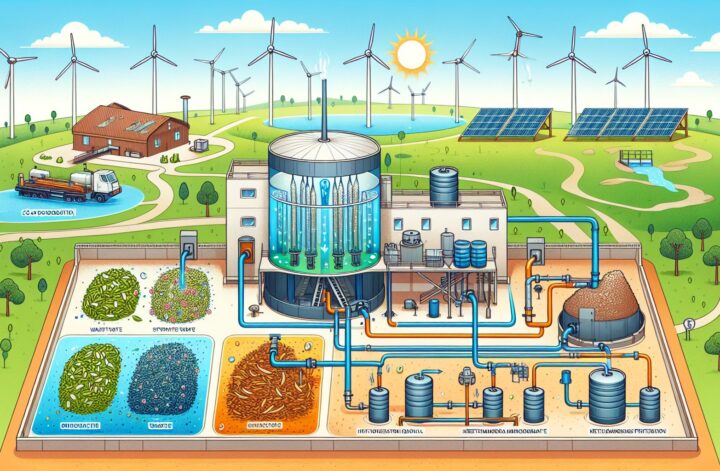In the era of growing environmental concerns and the desperate need to switch to renewable energy sources, the focus has lately shifted to a promising phenomenon: biogas production. Not only does it serve as an economical source of energy, but it also personifies the concept of a sustainable bio-economy.
Understanding Biogas
Biogas, a by-product of anaerobic digestion of organic waste, represents a mixture of several gases. The major components in it include methane (CH4) and carbon dioxide (CO2) which contribute around 60%-70% and 30%-40%, respectively[^1^].
The Production Process
The whole process of biogas generation is spearheaded by a simple yet complex mechanism of anaerobic digestion where organic materials are broken down by bacteria, in the absence of oxygen. This yields a mixture of gases and a solid residue known as “digestate”.
There are four main steps to the biological process involving different species of bacteria:
-
Hydrolysis: complex organic materials are broken down into simple sugars, amino acids and fatty acids.
-
Acidogenesis: further breakdown results in the formation of volatile fatty acids and alcohols.
-
Acetogenesis: the products from the second stage are converted into hydrogen, carbon dioxide, and acetic acid.
-
Methanogenesis: Methane and carbon dioxide, the major components of biogas, are formed in this final step[^2^].
Applications of Biogas
Heat and Power Generation
The biogas produced can be utilized to generate heat and electricity using combined heat and power (CHP) units. At the same time, it also helps in reducing the reliance on fossil fuels.
Organic Waste Treatment
It is also an effective method of waste treatment wherein it aids in the processing of different kinds of wastes, including municipal solid waste, industrial waste, agricultural waste, energy crops, and wastewater sludge. The treated organic waste offers a potential for curbing the release of harmful greenhouse gases, thus maintaining an appropriate carbon footprint.
Digestate: A Soil Enhancer
The solid by-product, digestate, resulting from the anaerobic digestion process holds rich nutrient value and can be used as a soil supplement or an organic fertilizer.
Vehicle Fuel
After an upgrading process which removes the carbon dioxide, the upgraded biogas, also referred to as biomethane, can be used as a renewable vehicle fuel.
Challenges and Solutions
Despite the advantages, biogas production is often met with numerous challenges. Ensuring feasibility calls for a balance amidst all technical parameters such as hydraulic retention time (HRT), organic loading rate (OLR), and the choice between mesophilic and thermophilic digestion.
Another major obstacle in the pathway is the inhibition of the anaerobic digestion process. It can occur due to numerous reasons such as pH fluctuations, presence of toxic substances, nutritional imbalance, or even process instabilities. To tackle these complications, monitoring the process parameters regularly, trace element supplementation or adopting methods of co-digestion can be fruitful[^3^].
The Future of Biogas
Biogas production offers a sustainable and economically viable option for energy generation. It remains a promising strategy amidst the growing need for renewable energy and waste treatment solutions. By addressing the challenges that hamper its efficiency, it can help unveil a future that accomplishes both: economic growth and environmental sustainability.
With the world gravitating towards a green economy, biogas will undeniably assert itself as a promising trend in shaping a sustainable future.
References
[^1^]: “What is Biogas? A Beginners Guide”, Home Biogas, accessed May 28, 2020, https://www.homebiogas.com/What_is_Biogas-A_Beginners_Guide.
[^2^]: Gerardi, Michael H., “The microbiology of anaerobic digesters”, Wastewater Laboratory Analysts’ Guide to Preparing for the Certification Examination, 4th Edition, accessed May 28, 2020, https://www.iwapublishing.com/news/microbiology-anaerobic-digesters
[^3^]: “Anaerobic Digestion”, Sustainable Energy Authority of Ireland, accessed May 28, 2020, https://www.seai.ie/technologies/anaerobic-digestion/




